
The Health Benefits Of Sprouts

Posted on 02 Oct, 2021

Do you remember sprouting a single kidney bean in a paper cup in kindergarten? After a few days the parts of the bean became evident: The fiber-rich outer layer, also known as the bran; the starchy middle, called the endosperm; and the vitamin-rich inner portion known as the germ or plant embryo that sent out the shoot that could eventually grow into a new plant. Although we most often eat ungerminated varieties, all plant seeds --including grains (which are the seeds of grasses), nuts and vegetable seeds -- are able to germinate or sprout new plants in this way.
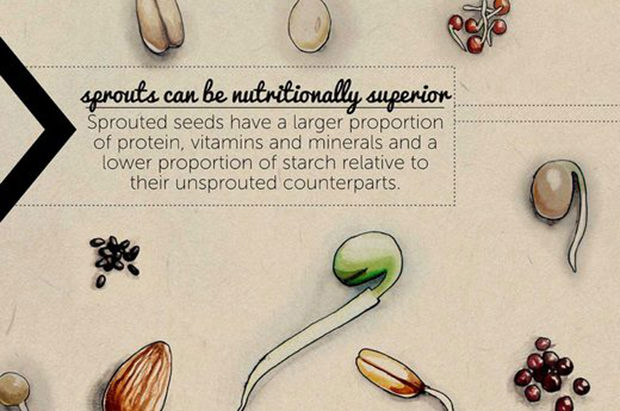 NUTRITIONALLY SUPERIOR SPROUTS
NUTRITIONALLY SUPERIOR SPROUTS
The nutritional profile of sprouted foods is superior in some ways to that of their unsprouted counterparts. Sprouted seeds have a larger proportion of protein, vitamins and minerals and a lower proportion of starch relative to their unsprouted counterparts because they digest some of the starch as fuel for their growth. Some people who have difficulty digesting the starches in beans or grains may therefore be able to eat sprouted varieties. Sprouting seeds also reduces their concentration of phytic acid, an indigestible compound that inhibits the absorption of minerals like iron, zinc and calcium -- making sprouted seeds a better source of these nutrients.
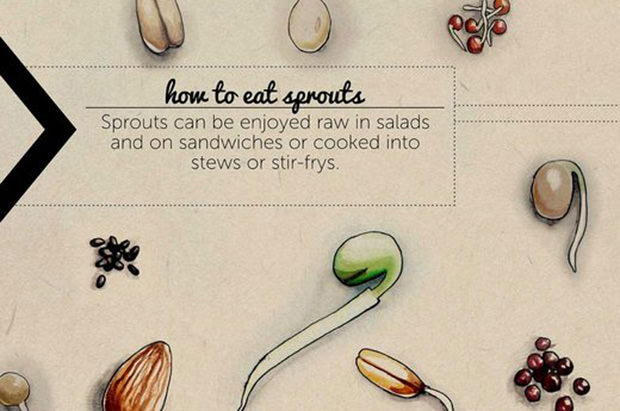 EDIBLE SPROUTS IN THE KITCHEN
EDIBLE SPROUTS IN THE KITCHEN
Sprouted-grain breads and sprouted nuts are becoming popular on grocery store shelves, though they’re often more expensive than conventional versions. Luckily, these nutritious foods are easy to make at home. Sprouts can be enjoyed raw in salads and on sandwiches or cooked into stews or stir-frys. With a good technique and a handful of seeds, you can easily produce these nutritious, delicious foods at home.
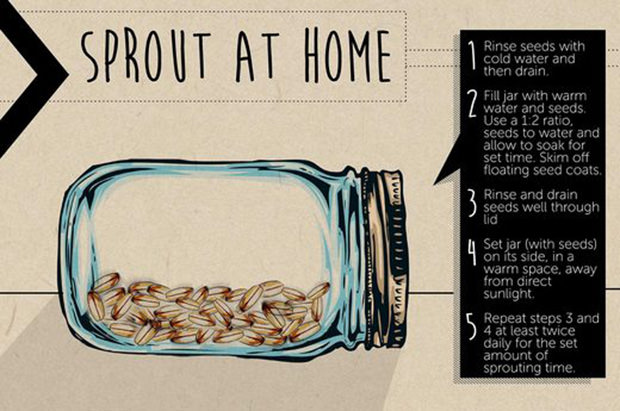 DIY SPROUTS AT HOME
DIY SPROUTS AT HOME
The most common approach requires soaking the seeds in a glass jar with a cheesecloth or mesh lid (or you can just use a fine mesh strainer). To start, give the seeds a good rinse with cold water and then drain. Next, fill the jar with warm filtered water with a one-to-two ratio of seeds to water and allow to soak for a period of time. Skim off any floating seed coats. Then rinse and drain the seeds well and set the jar (with the seeds) on its side in a warm space. This “rinse, drain and sprout” process is repeated at least twice daily for the specified amount of sprouting time. Because the conditions required for sprouting may also promote the growth of harmful bacteria, it is essential to follow the proper sanitizing technique to avoid the risk of foodborne illness. Here are nine different seeds you can start sprouting at home today.
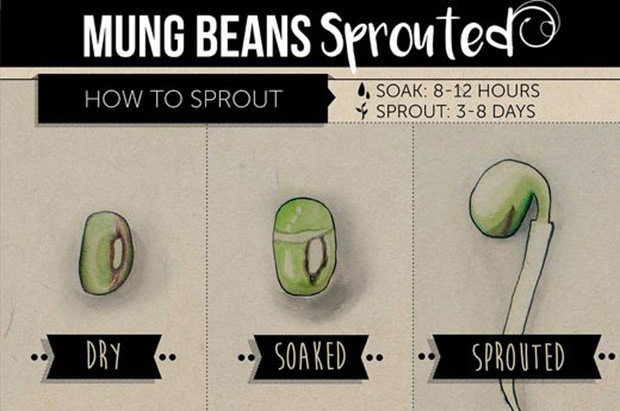 1 MUNG BEANS
1 MUNG BEANS
Mung bean sprouts are what we think of when we refer generically to “bean sprouts.” They’re about two inches long with a crunchy white body and a yellow tip. You’ve likely seen them floating in Vietnamese soups like pho or mixed in with your pad thai. If you have never sprouted them yourself, you might not know that these skinny white threads begin their life as small, semi-round bright-green beans. They’re neutral to slightly sweet in flavor and add freshness and crunch to just about any dish. Use them in salads, soups or stir-frys. Mung beans need to be soaked for eight to 12 hours and then sprouted for three to eight days while kept at room temperature and out of direct sunlight.
 2 QUINOA
2 QUINOA
If you’re new to home sprouting, the simple and fast technique for sprouting quinoa might be a good place to start. This pseudo-grain is actually a seed with a nutty, earthy flavor and a slightly crunchy texture. To sprout quinoa, simply rinse the seeds, soak for about 20 to 30 minutes and then rinse, drain and set aside out of direct sunlight and at room temperature for sprouting. Rinse and drain two or three more times at eight- to 12-hour intervals until the seeds produce tiny roots — no more than two to three days in total. Quinoa is unique among plant foods in that it contains all of the essential amino acids. Although already a highly nutritious food, sprouting activates certain plant enzymes that make the protein in quinoa more highly digestible and increases antioxidant activity of the seed.
 3 LENTILS
3 LENTILS
Lentils are a nutrient-rich food source, high in protein, fiber and iron. Although most people get enough iron in their diets, some groups -- particularly infants, young children, teenage girls, pregnant women and premenopausal women -- are at risk of insufficiency. “Many women of menstruating age don’t include enough iron in their diets, which is important to replenish monthly blood losses,” says Marissa Beck, M.S., RD, registered dietitian and corporate wellness nutritionist. “Just a half-cup of lentils provides almost one-fifth of a woman’s iron needs for the day.” Although lentils are high in iron, they also contain phytic acid and certain polyphenols that inhibit some of the absorption of the mineral. Sprouting reduces the concentration of these substances and increases bioavailability of iron and other minerals. Lentils need to soak for eight to 12 hours and then sprout for two to four days in room temperature and out of direct sunlight.
 4 SOYBEANS
4 SOYBEANS
Sprouted soybeans are highly nutritious, with a beneficial macronutrient profile. About 40 percent of the calories in sprouted soybeans are in the form of protein. One cup of steamed, sprouted soybeans contains only 76 calories and provides a good amount of calcium, iron and potassium. Despite the nutritional payoff, many people do not tolerate soy or other beans well due to difficulties digesting some of the starches found in them that lead to gas, bloating and other intestinal discomfort. The concentration of these compounds can be reduced through sprouting. Soybeans take about four to six days to sprout (at room temperature and out of direct sunlight). They require two to 12 hours to soak.
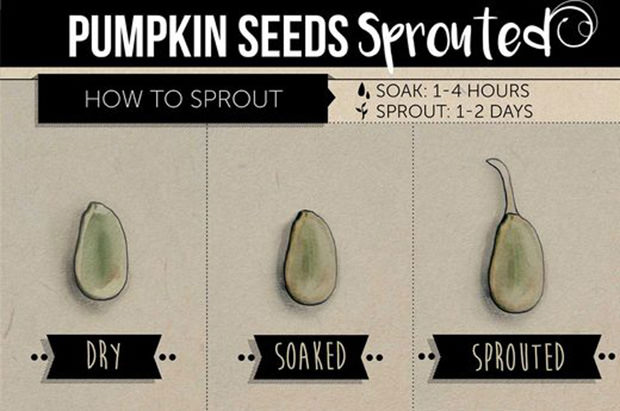 5 PUMPKIN SEEDS
5 PUMPKIN SEEDS
“Pumpkin seeds are a very nutritious food, packed with magnesium, zinc, iron and vitamin E,” says Olivia Martino, registered dietitian and owner of Nourish Northwest, a nutrition and fitness center in Portland, Oregon. “Unfortunately, they also contain a high amount of phytic acid, which not only inhibits the absorption of some nutrients, but can also be difficult to digest. The sprouting process significantly reduces the phytic acid content of these seeds, increasing their nutrient bioavailability and making them much more beneficial to health.” When buying seeds to sprout at home, look for raw, unpasteurized, nonirradiated pumpkin seeds, as seeds that have undergone those processing methods will not sprout new plants. Pumpkin seeds should soak for one to four hours and require one to two days to sprout at room temperature and out of direct sunlight.
 6 RYE
6 RYE
Whole grains are a good source of folate, the B vitamin that’s important for cell growth and division, which protects against birth defects, certain cancers and cardiovascular disease. Most people in the United States get enough folate, although certain groups, including over one-sixth of females ages 14 to 30, have inadequate intakes. Sprouting rye grains more than doubles their folate content. Sprouted grains have also been shown to raise blood sugar less than conventional grains, in part because of their higher fiber-to-starch ratio. Keep in mind that sprouted grains are still not suitable for someone with an allergy or intolerance to grain proteins (such as someone with celiac disease or gluten intolerance). Rye should soak for six to 12 hours and sprout for two to three days while kept out of direct sunlight and at room temperature.
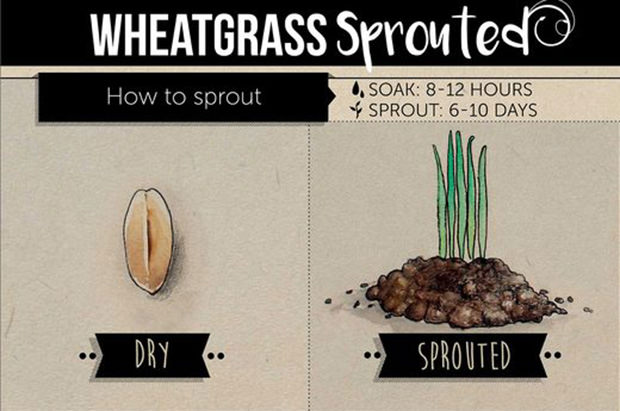 7 WHEATGRASS
7 WHEATGRASS
The bright-green juice known as wheatgrass is actually the liquid extracted from the sprouted grass of common wheat seeds. Because the grass is very high in fiber and difficult to digest, it’s typically made into a juice as a way to make available all the nutrients. Wheatgrass is highly nutritious, containing water- and fat-soluble vitamins and the minerals iron, calcium, magnesium and selenium as well as chlorophyll and amino acids. Wheatgrass requires an eight- to 12-hour soak and then a rinse and drain. Keep the seeds out of direct sunlight and rinse and drain every 12 hours for one day. Once the “root” starts to show, plant the grass and allow it to germinate for six to 10 days. A specialized wheatgrass juicer is needed to produce the juice.
 8 ALMONDS
8 ALMONDS
The health benefits of almonds are well known. They’re rich in heart-healthy monounsaturated fats and the antioxidant vitamin E, which protects cells against damage from free radicals. Like other seeds, sprouting significantly reduces the amount of phytic acid that inhibits absorption of important micronutrients, making sprouted almonds that much more nutritious. The sprouting process for almonds is relatively easy and takes only one to three days to sprout (out of direct sunlight) after soaking for four to 12 hours. This is in part because almonds, like other nuts, will not grow a new plant the way your kindergarten kidney bean did, but will simply swell in size so that you get 1.5 times the volume of almonds you started with. This is why they’re referred to as “soaks” and not actual sprouts.
 9 BASIL
9 BASIL
Basil sprouts are in a category of edible plants known as microgreens. As their name implies, they are the tiny greens produced from the seeds of the plant we usually consume in larger size. Basil microgreens taste just like larger-size basil and can have an even more potent flavor. Unlike grains, beans or nuts, herb seeds like basil do not require soaking, rinsing and draining. Instead, they need to be planted and kept in a lighted room at room temperature. They also take longer to produce sprouts -- between two and three weeks to harvest. Microgreens are found to have higher concentrations of micronutrients like vitamins C, K and E and carotenoids as compared with their larger plant counterparts and are a vibrant addition to salads and mixed dishes. Basil can be a tougher seed to grow, so you may not want to attempt this one first.
 SPROUT SAFELY
SPROUT SAFELY
Sprouting seeds at home is a relatively easy process, though proper technique must be followed to avoid contamination. Sprouts, like other raw produce, carry a risk of contamination with listeria, salmonella, E. coli or other bacteria. The warm, humid conditions they require are the conditions that bacteria thrive in. To reduce the risk, buy your seeds from a certified supplier, sterilize the seeds and keep them refrigerated before using. Make sure all of the jars, utensils and your workspace and hands are thoroughly cleaned as well. Children, the elderly, pregnant women and those with compromised immune systems should avoid raw sprouts.
WHAT DO YOU THINK?
Home cooks are beginning to use sprouted foods in their meals, and food manufacturers are making sprouted varieties of breads, cereals and other grain or seed products. Will you start sprouting today? Let us know in the comments below.
Great Books On How To Eat Right

by Jonny Bowden

by Julie Morris

by Julie Morris

by Donna Schwenk
 38 Things You Can Freeze To Save Time And Money
38 Things You Can Freeze To Save Time And Money Fermented Foods And Why They Are So Good For You
Fermented Foods And Why They Are So Good For You Pulses - What are they and why you should be eating them!
Pulses - What are they and why you should be eating them! Why You Should Be Soaking Your Nuts
Why You Should Be Soaking Your Nuts










